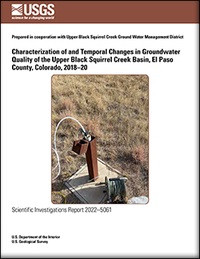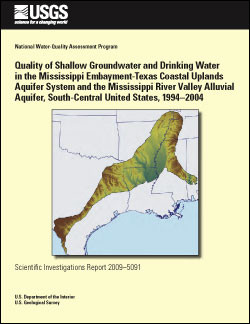
Product Details
- Product Number
- 534145
- Series
- SIR-2022-5061
- Scale
- NO SCALE
- Alternate ID
- SIR2022-5061
- ISBN
- 978-1-4113-4474-7
- Authors
- CHARLETON R BERN
- Version Date
- 01/01/2022
- Regions
- CO
- Countries
- USA
- Media
- Paper
- Format
- Bound
Additional Details
- Description
-
Characterization of and Temporal Changes in Groundwater Quality of the Upper Black Squirrel Creek Basin, El Paso County, Colorado, 2018–20
First posted June 30, 2022
For additional information, contact: Director, Colorado Water Science Center U.S. Geological Survey Box 25046, MS-415 Denver, CO 80225
Abstract
In 2018–20, the U.S. Geological Survey, in cooperation with Upper Black Squirrel Creek Ground Water Management District, sampled 48 wells for Phase III of a multiphase plan investigating groundwater quality in the alluvial aquifer of the Upper Black Squirrel Creek Basin (UBSB), El Paso County, Colorado. Results for samples collected from October to December each year were used to assess spatial and temporal changes in groundwater quality and to differentiate sources of nitrate. Groundwater was predominantly classified as mixed-cation and mixed-anion water type in the aquifer, with variable chemistry along the periphery. Concentrations of constituents in groundwater were generally less than regulatory standards, except for nitrate in four wells. Isotopes of nitrogen and oxygen in nitrate identified four different potential sources or processes affecting nitrate in the alluvial aquifer: naturally occurring nitrate from soils, nitrate from animal and (or) human waste, and an unknown source, along with evidence of denitrification. Pharmaceutical compounds and personal-care products were detected in seven wells, with three wells having multiple detections. Stable isotopes of water indicated variability in seasonality of recharge throughout the UBSB alluvial aquifer. Nitrate concentrations from the 1984 study and the 1996 study were compared to the more recent concentrations in the 2013 study and the 2018–20 study. The northern one-third of the UBSB alluvial aquifer had a statistically significant increase in nitrate concentration from the 2013 study to the 2018–20 study, but no change was shown from the 1984 study to the 1996 study. The opposite was found true for the southern two-thirds of the UBSB alluvial aquifer with no statistically significant difference in nitrate concentration from the 2013 study to the 2018–20 study. Analysis of temporal changes indicated an increase in median and maximum nitrate concentrations from the 2013 study to the 2018–20 study throughout the UBSB alluvial aquifer. Continued sampling of wells in the UBSB would be beneficial to better determine temporal changes in groundwater quality, characterize human effects on water quality, and understand characteristics of the alluvial aquifer pertaining to sustainability of the resource.
- Survey Date
- 2022
- Print Date
- 2022
- Height In Inches
- 11.000
- Length In Inches
- 8.500
- Two Sided
- Yes
- Pieces
- 1
- Languages
- English




